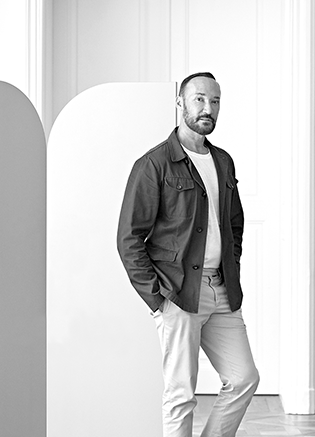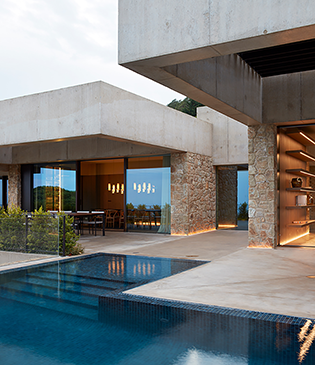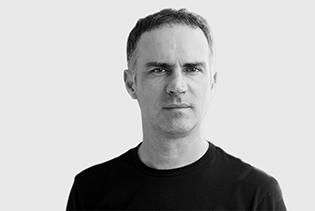In the second interview with a long-standing LZF collaborator, we talk to Ray Power, an Irish-born designer who has worked with the company since 1998. Like Burkhard Dämmer, Ray has created a number of LZF’s standout and award-winning lighting fixtures. They include the Air, Escape, Link, New Wave, and Swirl lamps. Ray’s latest lamp is Lola, a design that highlights his ability to create imaginative three-dimensional forms. Available in several versions—suspension, table (standard or lux), floor, and wall—Lola is especially noticeable for its intricate geometric pattern.

Ray Power.
In Ray Power, we find a designer who understands not only geometry and three-dimensionality, but the subtle nuances of lighting design that ensure his lamps stand apart.
A Q&A with Ray Power (RP).
What intrigues you most about lighting design?
(RP) No matter what I am designing, I find it stimulating and fascinating to go through the process, coming to a conclusion. However, lighting design has that one additional, magical element: light. Working with light and shade, translucency and transparency, makes for a lot of fun.
Your designs combine aesthetic quality with practical application. How do you balance these two design principles?
(RP) I don’t always approach a design in the same way, and don’t know what I’m looking for until I have a clear picture in mind of what I want the design to be. Until then, it’s like fumbling around in a dark room, picking something up, playing with it for a while, and waiting to see what happens. Sometimes the magic doesn’t happen and I’ll get tired of the idea, put it back in the dark room, then look around for something else instead. When I do eventually get a clear picture of something, it will have a strong aesthetic. Going forward, I make sure I keep my feet on the ground, offering LZF a design I believe they can produce well and subsequently sell.

Swirl by Ray Power.
What are your thoughts on automation and the design industry’s increasing reliance on new technologies? Are you concerned about the future of the craftsman and the designer?
I think there will always be a person at the helm of the design process. No matter what technology is used, it remains a tool in the hands of the builder. And while many traditional handcrafting techniques are endangered, new techniques do come along. Of course, we shouldn’t discard those established methods too quickly—the person who is best prepared to apply any new technique, will also understand the value of traditional craftsmanship.
You have worked with LZF for more than twenty years, designing some of the company’s standout fixtures (Escape, Link, Lola, Swirl). What keeps you coming back for more?
It’s a great opportunity to show what I can do. LZF is invested in defining its own rules, curating a collection where each lamp is unique—they stand apart from anything else that’s out there. Having worked with LZF for such a long time, I know the company very well, and I have a good idea of what they are looking for.

Escape by Ray Power.
In what has been a truly tumultuous year, many people are doubtless looking for something that offers hope and stability. How do you think design can work to improve our sense of self, space, and place?
Designers are always looking at the world around them and asking these questions. I’d like to think we can be part of the solution to the world’s problems, but at this time I believe scientists should be in the spotlight.
Are there any design clichés that you find especially irritating or redundant, or conversely, that you live by?
Honestly, they are all a bit annoying if you think about it. I do like ‘God is in the details’, something the German architect Mies van der Rohe is meant to have said. A lot of people say ‘The devil is in the detail’, which cracks me up. You just never know if the next designer you meet is a good Christian citizen or a satan worshiper!

Lola Lux by Ray Power. LZF’s Mariví Calvo designed the black Spanish Marquina marble base.
One of my favourite LZF lamps is the Nut pendant, purely for its relative simplicity and elegance. Do you have a favourite lamp?
Yes, I get what you mean: the simpler the design, the more time we have to admire the beauty of the warm diffused light, and the illuminated wood grain. But wood veneer is also an interesting structural material. In that respect, I like Burkhard Dämmer’s Pod, which is nice and solid, and the shading of Remedios Simón’s Spiro. As for my own designs for LZF, I’m very fond of the colour combinations in New Wave and the texture of Lola.
A selection of Ray Power’s lighting designs for LZF

Nut by Ray Power.

New Wave by Ray Power.

Lola (suspension) by Ray Power.

Hide & Seek (suspension) by Ray Power.

Link Chain by Ray Power.

Air (wall) by Ray Power.













